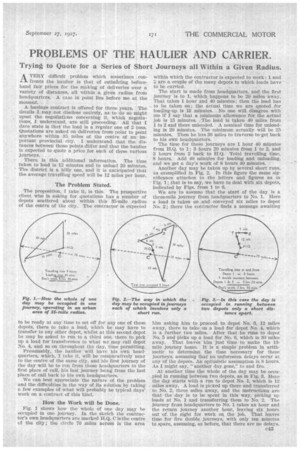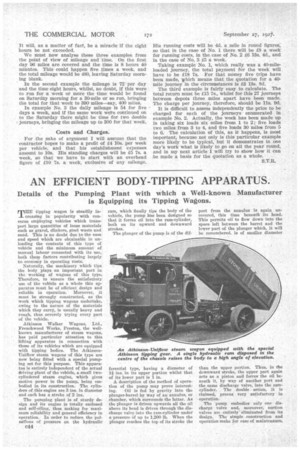PROBLEMS OF THE HAULIER AND• CARRIER.
Page 65

Page 66

If you've noticed an error in this article please click here to report it so we can fix it.
Trying to Quote for a Series of Short
AVERY difficult problem which sometimes confronts the haulier is that of estinikting beforehand fair prices for the making of deliveries over a variety of distances, all within a. given radius. from headquarters. A case in point lies before me at the
moment. . .
A -haulage contract 'is offered for three years. The details I may. not disclose entirely, as to -do se might upset the negotiations concerning it, which negotiations; I understand, are still proceeding. All that I dare state is that the load is a regular one of 2 tons. Quotations are asked ondeliveries from-point to point ,anywhere within 35 miles of. the centre of animportant provincial city. I understand that the distances between those points differ and that the haulier is expected to quote a price for each of these various journeys. .
Thera is this additional information. The time taken to load is 12 minutes and to unload 20 minutes. The district is a hilly one, and it is anticipated that the average travelling speed will be 12 miles per hour.
The Problem Stated.
The proposition, I take it, is this. The prospective client who is asking for quotations has a number of depots scattered about within this 35-mile radius of the centre of the city. The contractor is expected to be ready at any time to set off for any one of these depots, there to take a load, which he may have to transfer to any other depot, whilst at this second .depot be may be asked to run to a third one, there to pick up a load for transference to what we may call depot No. 4, and so on throughout the day, time permitting.,
Presumably, the haulier will have 'his own headquarters, which, I take it, will be comparatively near to the •centre of the same city, and his -first journey of the day will be to run from those headquarters to the first place of call, ,his last journey being from the last place of call back to his own headquarters.
We can best appreciate the nature ofthe problem and the difficulties in the way of its solution by taking a few examples of what will probably be typical days' work on a contract of this kind.
How the Work will be Done.
Fig. 1 shows how the whole of one day may be occupied in One journey. In the sketch the contractor's own headquarters are marked H.Q. C is the centre cf the city; the circle 70 miles across is the area
Journeys all Within a Given Radius.
within which the contractor is expected to work: 1 and 2 are a couple of the many depots to which loads have to be carried.
The start is made from headquarters, and the first journey is to 1, which happens to be 20 Miles away. That takes 1 hour and 40 minutes; then the load has• to be taken on ; the actual time we are quoted for loading-up is 12 minutes. No one will disagree with me if I say that a minimum allowance for the actual job is 15 minutes... The load is taken 40 miles from 1 to 2 and there unloaded. A nominal time for unloading is 20 minutes. The ininintum actually Will be 25 minutes. Then he has 36 miles to traverse to-get back to his own headquarters.
The time for these journeys are 1 hour 40 minutes from H.Q. to 1; 3 hours 20 minutes from 1 to 2, and 3 hours from 2 back to H.Q. Total travelling time, 8 hours. Add 40 minutes for loading and unloading, and we get a day's work of 8 hours 40 minutes.
Another day may he taken up by several short runs, as exemplified in Fig. 2. In this figure the same significance attaches to the letters and figures as in Fig. 1; that is to say, we have to deal with six depots, indicated by Figs. from 1 to 6. " We are to assume that the start of the day is a three-mile journey from headquarters to No. 1. Here a .load is taken on and. conveyed six miles to depot No. 2; there the contractor finds a message awaiting
him asking him to. proceed to depot No. '3, 12 miles away, there to take on a load for depot No. 4, which is a further two miles. After that he runs to depot No. 5 and piCks up a load for No. 6, which is 30 miles away. That leaves him just time to make the 13Mile journey home. It is a simple problem in arithmetic to determine the time necessary for these journeys; assuming that no unforeseen delays occur at any of the depots. An optimistic assumption is 8 hours. As I might say, "another day gone," to and fro.
At another time the whole of the day may he occupied in running between two depots, as in Fig. 3. Here the day starts with. a run to depot No. 1, which is 12 • miles away. A load is picked up there and transferred to No. 2, three miles away, and the instructions • are that the day. is to be spent in this way; picking up loads at No. 1 and transferring them to No. 2. The journey from headquarters to No. 1 takes an hour and the return journey another hour, leaving six hours out of. the eight for work on the job. That leaves time for five double journeys, with only ten minutes to spare, assuming, as before, that there are no delays.
It will, as a matter of fact, be a miracle if the eight hours be not exceeded.
We must now analyse these three examples from the point of view of mileage and time. On the first day 96 miles are covered and the time is 8 hours 40 minutes. This could happen five times a week, and the total mileage would be 480, leaving Saturday morning blank.
In the second example the mileage is 72 per day and the time eight hours, whilst, no doubt, if this were to run for a week or more the time would be found on Saturday morning for a 30-mile or so run, bringing the total for that week to 390 miles—say, 400 miles.
In example No. 3 the daily mileage is 54 for five days a week, and if the same work were continued on to the Saturday there might be time for two double journeys, bringing the mileage up to 300 for that week.
• Costs and Charges.
For the sake of argument I will assume that the contractor hopes to make a profit of £4 10s. per week per vehicle, and that his establishment expenses amount to 10s. His standing charges will be £5 7s. a week, so that we have to start with an overhead figure of £10 7s. a week, exclusive of any mileage. His running costs will be 4d. a mile in round figures; so that in the case of No. 1 there will be £8 a week for running costs, in the case of No. 2 £6 13s. 4d., and in the case of No. 3 £5 a week.
Taking example No. 1, which really was a 40-mileloaded journey, the total payment for the week will have to be £18 7s. For that money five trips have been made, Which means that the quotation for a 40mile journey in the circumstances is £3 13s. 8d.
The third example is fairly easy to calculate. The total return must be £15 7s., whilst for this 27 journeys between depots three miles apart have been made. The charge per journey, therefore, should be us. Oil.
It is difficult to assess independently the price to be charged for each of the journeys enumerated in example No. 2. Actually, the week has been made up in taking six loads six miles from 1 to 2; five loads two miles from 3 to 4, and five loads 30 miles from 5 to 6. The calculation of this, as it happens, is most important, because not only is this particular example more likely to be typical, but it demonstrates in one day's work what is likely to go on all the year round, and in my next article I will try to show how it can be made a basis for the quotation as a whole.












































































































